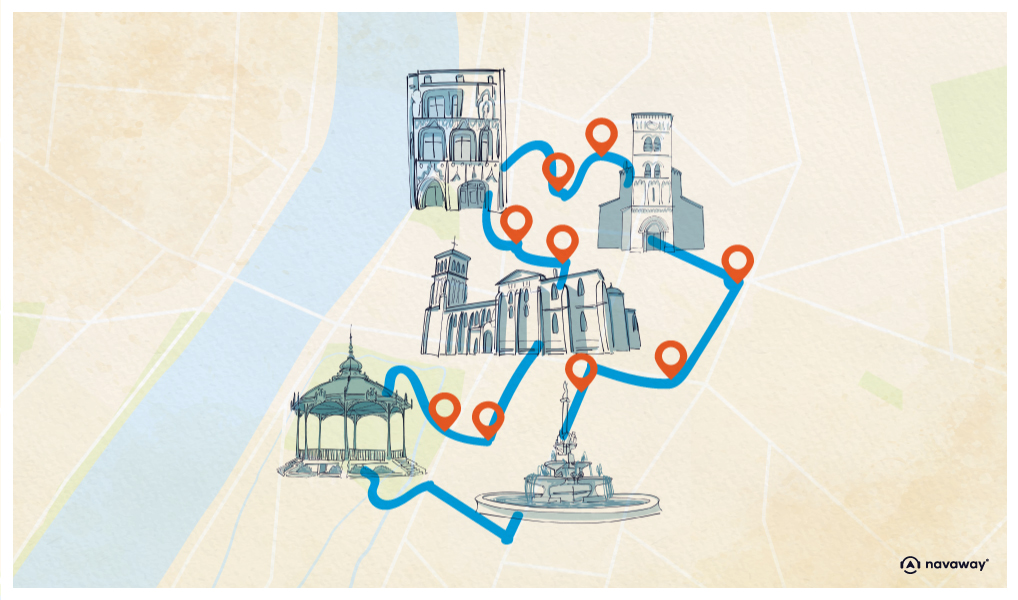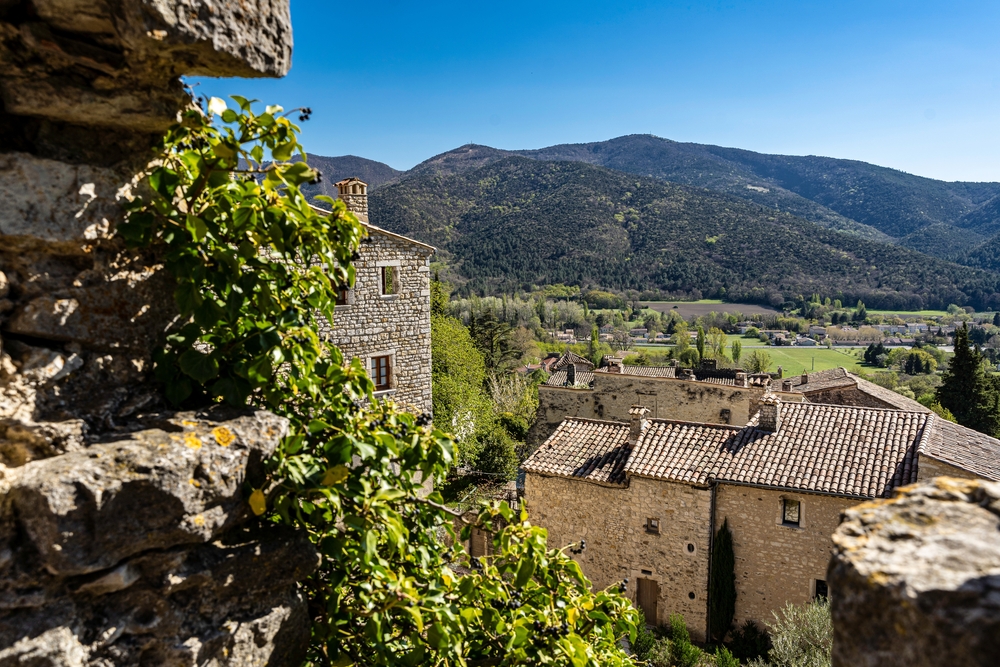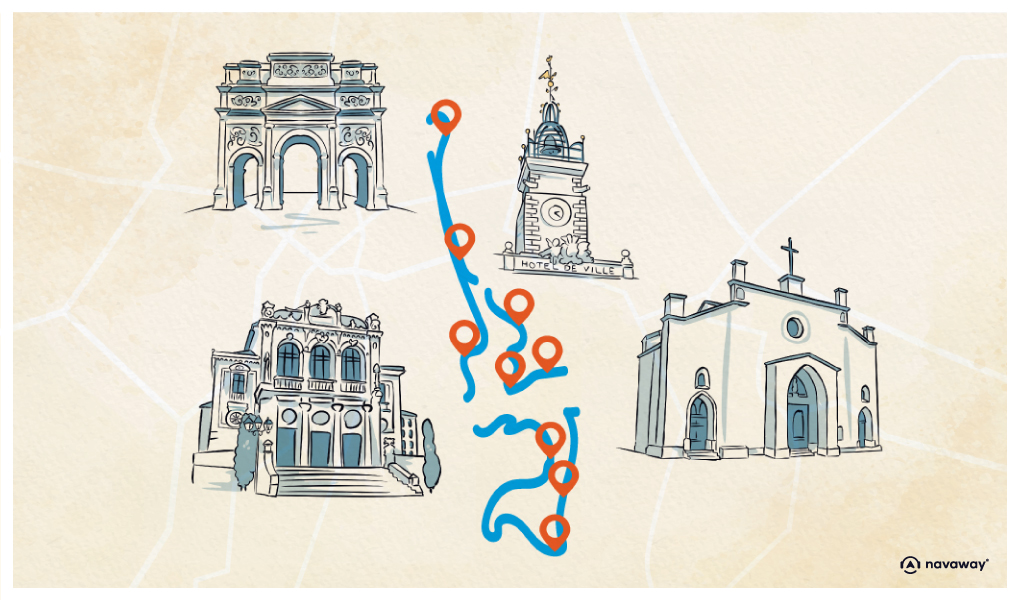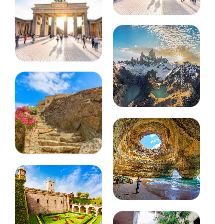
Discover 7 Must-See Places in Le Poët-Laval, in the Heart of Drôme Provençale

Nestling in the heart of the Drôme Provençale, Le Poët-Laval is a medieval gem that appeals to visitors looking for authenticity and history. Listed as one of the Most Beautiful Villages in France, this hilltop village boasts an exceptional heritage inherited from the Order of the Hospitallers of St John of Jerusalem. With its cobbled streets, blonde stone architecture and breathtaking views over the Jabron valley, Le Poët-Laval promises to be an unforgettable getaway. Whether you’re a history buff, a lover of contemporary art or simply looking for some peace and quiet, this medieval village will charm you with its unique atmosphere and enchanting setting. Discover the 7 must-see things to do in Le Poët-Laval to make the most of your visit.

See also the Provence and Rhône-Alpes guide :
- Discover the village of Chabeuil near Valence
- What are the 5 most beautiful villages in the Vercors?
- The 10 best walks in the Vercors
- 20 must-see weekend ideas around Lyon
- 11 must-see spots for mountain biking in France
- Top 10 of the most beautiful villages in the Ardèche
- 5 of the most beautiful villages around Lyon to visit this autumn
1. Stroll through the old medieval village

Starting your visit to Le Poët-Laval with a stroll through the old village is an absolute must. As soon as you enter the narrow cobbled streets, you are immediately transported back to the Middle Ages. The blonde stone houses, typical of the Drôme Provençale region, stand on either side of picturesque vaulted passageways and stairways. Every nook and cranny of the village tells a thousand-year-old story, that of a former commandery of the Hospitaller Order founded in the 12th century.
Take a stroll through the village and you’ll discover some fascinating architectural details: carved old doors, mullioned windows, covered passageways and shady squares where you’ll love stopping off. The village has remarkably preserved its authenticity, with its ramparts and fortifications bearing witness to its defensive past. Don’t miss the breathtaking view from the village heights over the Jabron valley and the surrounding hills planted with lavender and olive trees.
The peaceful, unspoilt atmosphere of Le Poët-Laval makes it an ideal place to recharge your batteries away from the hustle and bustle of the city. Take the time to lose yourself in this medieval maze, admire the play of light on the old stones and breathe in the scents of Provence in the narrow streets. It’s this unique atmosphere that has earned the village its place among the Most Beautiful Villages in France.
2. Discover Le Poët-Laval castle
Perched at the highest point in the village, the Château du Poët-Laval (26160 Le Poët-Laval, open from April to October) is the emblematic monument of this medieval town. This imposing fortress was built in the 12th century by the Hospitallers of St John of Jerusalem to protect pilgrims on their way to the Holy Land. What began as a simple defensive keep was gradually extended over the centuries to become a fortified complex in its own right.
A visit to the castle plunges you into the fascinating history of this religious and military order. You can admire the medieval military architecture with its watchtowers, loopholes and thick ramparts. From the heights of the castle, the panorama of the Drôme provençale is simply breathtaking: the Jabron valley stretches as far as the eye can see, dotted with fields of lavender and centuries-old olive trees.
The château regularly hosts exhibitions of contemporary art, creating a striking and successful contrast between the age-old stonework and the modern works. This cultural enhancement of the castle’s heritage makes it a living place where past and present meet. You can visit on your own or with a guide to find out more about the Hospitaller Order and the eventful history of the village.
3. Visit the Musée du Protestantisme Dauphinois
The Musée du Protestantisme Dauphinois (26160 Le Poët-Laval, rated 4.5/5 on Google for 83 reviews) is an essential place of memory for understanding the tumultuous religious history of the region. Housed in a 15th-century residence that served successively as a community house, Protestant temple and church, the museum passionately traces the history of the Reformation and the Wars of Religion, which had a profound effect on the Dauphiné.
The permanent exhibition features a rich collection of historical objects, archive documents, old Bibles and accounts of the lives of Protestants in the Dauphiné over the centuries. In particular, you’ll discover the poignant story of the Huguenots, the French Protestants forced into exile after the revocation of the Edict of Nantes in 1685. The museum also looks at the crucial role played by Le Poët-Laval as a Protestant refuge in a region long torn apart by religious conflict.
The visit is enhanced by detailed explanatory panels and re-enactments to give a better understanding of this complex period in French history. The museum regularly organises conferences and cultural events to liven up village life. It’s a must for anyone interested in the region’s religious history and cultural heritage.
4. Admire the chapel of Saint-Jean-des-Commandeurs

The Saint-Jean-des-Commandeurs chapel (26160 Le Poët-Laval, listed as a Historic Monument) is a jewel of Romanesque architecture that is well worth a visit. Built in the early 13th century, this chapel served as both a parish church and a chapel for the Knights Hospitallers. Its sober, elegant architecture bears witness to Provençal Romanesque art in all its purity.
Although partly in ruins today, the chapel retains a melancholy beauty that leaves no one indifferent. The remains of the thick walls, the semi-circular apse and a few sculpted features are reminders of the past grandeur of this religious building. Its dominant position within the village also offers exceptional views over the roofs of Le Poët-Laval and the surrounding countryside.
The chapel has survived the centuries and the vicissitudes of history, particularly the Wars of Religion, which caused extensive damage. It was converted into a Protestant church in the 17th century before gradually falling into disuse. Now protected as a Historic Monument, it is being preserved as a precious reminder of the village’s medieval past.
5. Explore the Yvon Morin art centre
The Yvon Morin art centre (95 Place Yvon Morin, 26160 Le Poët-Laval) is a dynamic cultural institution that breathes contemporary energy into this medieval village. Founded in 1995 by artist Yvon Morin, the centre occupies a building that is remarkably well integrated into the village’s architectural heritage. Spread over 300 square metres and three floors, the exhibition spaces showcase the works on display to remarkable effect.
The centre organises temporary exhibitions of contemporary art throughout the year, attracting both established and emerging artists. Painting, sculpture, photography, installations: all forms of artistic expression are represented. This eclectic, high-quality programme makes Le Poët-Laval an important cultural destination in the Drôme provençale, far beyond its medieval heritage alone.
But the art centre is not limited to visual exhibitions. It also has an outdoor theatre and an auditorium that host jazz and classical music concerts, theatrical performances and a variety of other shows. This rich cultural programme livens up the village and creates a festive atmosphere that is particularly appreciated on summer evenings. Don’t hesitate to consult the programme during your visit to enjoy a cultural event in this exceptional setting.
6. Walking the footpaths around the village

The area around Le Poët-Laval offers wonderful walking and cycling opportunities to discover the natural beauty of the Drôme Provençale. A number of signposted routes leave directly from the village and allow you to explore the surrounding hills, lush green valleys and nearby villages. These routes take you through typically Provençal landscapes, with their lavender fields, centuries-old olive groves and famous vineyards.
The Chemin des Huguenots, which symbolically begins at the Musée du Protestantisme Dauphinois, is a particularly emblematic long-distance hiking trail. This 1,600-kilometre route traces the exile of French Protestants after the revocation of the Edict of Nantes, from Le Poët-Laval via Switzerland to Bad Karlshafen in Germany. Even if you only cover a small section of this historic route, it’s an experience charged with emotion and meaning.
For cycling enthusiasts, there are a number of cycle routes to explore the region on two wheels. The 16-kilometre Chabotte loop is particularly popular for its varied route, which alternates between shady undergrowth and uninterrupted views over the Drôme countryside. These outdoor activities are ideal for complementing your cultural visit to the village with an immersion in the unspoilt nature of the Drôme Provençale.
7. Savour the local gastronomy at Les Hospitaliers
No visit to Le Poët-Laval would be complete without a gastronomic stopover at thehotel-restaurant Les Hospitaliers (95 Place Yvon Morin, 26160 Le Poët-Laval, rated 4.5/5 on Google out of 500 reviews). This local institution is nestled in the heart of the medieval village, in an absolutely enchanting setting that harmoniously blends ancient stone with contemporary comfort. For decades, the establishment has perpetuated a tradition of culinary excellence that has made its reputation far beyond the region.
Chef Alexandre Dartois, a Maître Restaurateur, offers refined cuisine that brings out the best in local produce from the Drôme and Provence. His menu changes with the seasons to celebrate the best local ingredients: lamb from the Drôme, truffles from Tricastin, picodon from the Dieulefit region, fruit and vegetables from local producers. Each plate is a work of art that delights the eye as much as the taste buds, in a perfect balance between tradition and creativity.
The restaurant’s panoramic terrace offers spectacular views over the Jabron valley and surrounding mountains, creating a romantic and soothing atmosphere, particularly magical at sunset. The attentive service and carefully selected wine cellar complete this exceptional gastronomic experience. Whether it’s for a gourmet lunch after your visit to the village or a refined dinner in the evening, Les Hospitaliers is the gastronomic highlight of your stay in Le Poët-Laval.

In conclusion, Le Poët-Laval is an exceptional destination that harmoniously combines medieval heritage, vibrant culture and Provencal authenticity. This village, listed as one of the Most Beautiful Villages in France, richly deserves its title thanks to its imposing castle, its museum of Protestantism, unique in France, its narrow streets steeped in history and its dynamic cultural life. From strolls through the old village to historical discoveries, hikes in the Drôme countryside and gastronomic delights, Le Poët-Laval offers a complete getaway that will delight visitors in search of authenticity and beauty. Whether you spend a day or a whole weekend here, you’ll leave captivated by the timeless charm of this pearl of the Drôme provençale, just twenty kilometres from Montélimar.
Frequently asked questions about Le Poët-Laval
How do I get to Le Poët-Laval?
Le Poët-Laval is located in the Drôme provençale, around 20 kilometres south-east of Montélimar. By car, take the A7 motorway and exit at Montélimar Sud, then follow the D540 towards Dieulefit. The village is easily accessible, with free parking at the entrance to the medieval village. The nearest airports are Valence (80 km), Avignon (100 km) and Lyon (150 km).
What are the opening times for the château and the museum?
The Château du Poët-Laval is open to the public from April to the end of October, generally from 3pm to 6.30pm (extended hours in July and August from 10am to 12pm and from 3pm to 6.30pm). The Musée du Protestantisme Dauphinois follows the same opening hours, but is closed on Monday and Sunday mornings. It is advisable to check the exact opening times before your visit, as they may vary according to the season.
Is Le Poët-Laval suitable for families?
Absolutely! The village is perfect for a family visit. Children will love exploring the medieval castle and discovering the picturesque alleyways, which resemble a fairytale setting. The surrounding hiking trails are also accessible to families with children. However, bring good shoes as the village is entirely pedestrianised and the cobbled streets can be steep.
How long will it take to visit Le Poët-Laval?
Allow at least half a day to discover the essence of the village: stroll through the narrow streets, visit the castle and the Protestantism Museum. If you want to take full advantage of the local atmosphere, have lunch at the Les Hospitaliers restaurant and perhaps go for a walk in the surrounding area, you’ll need a full day. The village is also ideal for a relaxing weekend in Drôme provençale.
What villages can I visit near Le Poët-Laval?
The region is full of charming villages to discover. Less than 10 kilometres away, don’t miss Dieulefit, renowned for its potters and ceramists. Further north, Montélimar is worth a visit for its castle and nougat factories. The Baronnies Provençales Regional Nature Park also boasts some magnificent hilltop villages, such as Pont-de-Barret. For lovers of remarkable sites, Grignan and its majestic château are around 30 kilometres away.
200 audioguided tours for cities all around the world
Download
